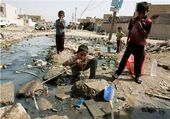
Cholera, a disease that gives victims diarrhea so severe they can die 18 hours after their first liquid stool, is caused by a bacterium, Vibrio cholerae. Humans become infected after eating contaminated food or water. Cholera outbreaks usually occur in developing countries, such as India, Bangladesh and in Afica, although Colwell says that she's found the bacterium in Eastern U.S. coastal waters as well.
Vibrio cholerae is associated with a type of crustacean called a copepod that appears naturally in many areas of the world. The copepods feed on zooplankton, which in turn feed on phytoplankton. Phytoplankton use photosynthesis to harvest energy from the sun to create their food.
Colwell and her colleagues use this food ladder to their advantage. Higher sea temperatures encourages photosynthesis. Higher sea levels brings that phytoplankton, and later cholera, closer to humans.
Satellites can currently measure sea temperature, sea height and chlorophyll concentrations. Colwell hopes that future satellite data will also include information on salinity, oxygen saturation and other variables, which could help increase the accuracy of their models.
Colwell and her colleagues correlated the environmental data with infection statistics in several countries to create a model that can predict the severity of cholera outbreaks four to six weeks before the first individual is infected.
At one point during their analysis the scientists had environmental data from a province in Bangladesh, a country with seasonal cholera outbreaks, but didn't know how many people had been infected with cholera.
The scientists decided to conduct a mini experiment. Using their model, the scientists predicted that out of every 1,000 people who walked into a particular hospital, 24 of them would be infected with cholera.
To test their result, the scientists e-mailed doctors in Bangladesh and asked for the actual number of infected individuals for the months between April and June, one of two times each year the number of cholera infections spike. Twenty-five out of every 1,000 individuals at the hospital had been infected with cholera.
Working backwards in time is useful theoretically but doesn't help those at risk of contracting a disease that can kill within 18 hours. Within the next three to four years that could change, says Colwell. By then Colwell expects her team will accurately predict the time and size of future cholera epidemics four to six weeks before the first individuals become ill.
"Having a tool to predict outbreaks like cholera would be very helpful to public health authorities by making sure that adequate supplies for rehydration therapy and antibiotics are available to treat the disease," said David Hamer, an infectious disease specialist at Boston University.
"But I wonder about how widely applicable this is to places without recurrent outbreaks," said Hamer.
Colwell thinks that her model can be used to predict unexpected cholera epidemics, and points to a 1991 cholera outbreak in Peru as an example.
The South American country hadn't seen cholera in about 100 years, but a massive El Nino warming in the Pacific Ocean triggered a spike in phytoplankton, and later Vibrio cholerae, that satellite images could have detected. An estimated 14 million people were infected.
Cholera is not the only disease where environmental factors could be used to predict future outbreaks either, says Colwell.
"Hanta virus, malaria, influenza and other diseases are very climate-driven," said Colwell. "We are just beginning to understand the ecology of these infectious diseases."



Reader Comments
to our Newsletter